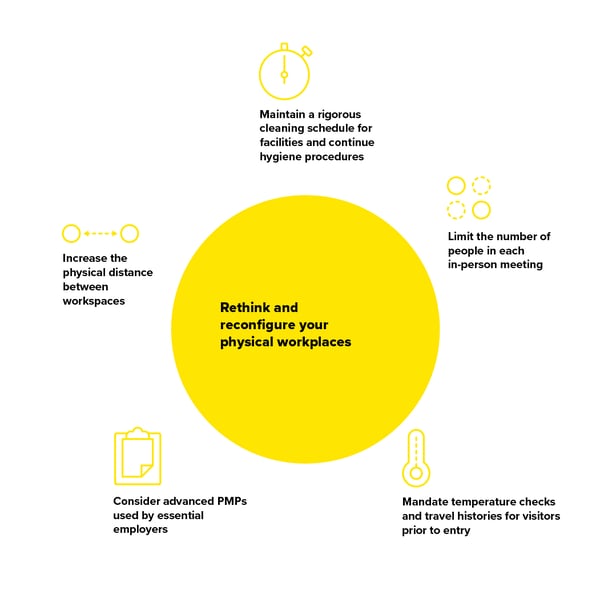Blog
Returning to work post COVID-19: What you need to consider

A return to regular work is imminent for many employees across the world, as restrictions in place as part of the post COVID-19 response are reviewed.
It’s a welcome move for many businesses, however, a reintroduction to office life can be dangerous if mishandled. Despite this warning, only 10% of executives surveyed recently have done “extensive” planning.
Planning to reintegrate back to business premises needs to maintain safety, manage resources and rebuild morale. Below are 7 considerations to ensure a successful transition back to work.
1. Manage employee numbers
Large numbers returning to a workplace raises a risk for spreading viruses. Managing the number of workers will be critical to protecting health. The higher the number, the higher the risk.
Plan a staggered reintroduction to the office. Establish a process such as rotating a group of employees working from the office every few days. Restricting employee numbers will create a greater need for shift coverage. Beyond healthcare and similar essential services, this will also affect call centers, retail, manufacturing and other industries.
2. Maintain remote working
It is wise for businesses to continue remote working for several months (at least). The reasons for this are financial and practical.
Rolling lockdowns may continue for some time in regions where the threat of COVID-19 remains high. Seesawing back and forth between central and remote working is disruptive.
Many organisations will keep staff working from home for economic reasons. Others may have a return to remote working if a staff member contracts the virus. This enforces the importance of an effective communications platform to connect with home workers.
3. Rethink physical setup
Reopening of workplaces won’t remove all restrictions imposed during and post COVID-19, as businesses will still need to observe regulations governing social distancing and hygiene practices.
Businesses will need to be proactive in re-configuring their office. The requirement for 6 feet between employees impacts on individual seating arrangements and shared spaces like cafes.
Some considerations for rethinking physical workplaces have been summarized by Forrester research.

4. Rebuild workplace morale
The human component of returning to work requires as much focus as the practical one. For staff who have been away from their workplaces, returning may feel unsettling. Much may have changed in the interim. Some of their old teammates may not be returning at all.
Successful businesses thrive on motivated work-forces, so it’s important leaders rebuild workplace morale. Acknowledge employee concerns and treat announcements regarding the new operating environment with sensitivity.
There are many ways businesses can improve workplace culture, including promoting achievements, encouraging collaboration and painting a positive vision of the future. When the time is right, host a fun team-building event to lift spirits.
5. Review infrastructure needs
For most businesses, it will take months to return to how it was prior to COVID-19. That means there are now likely to be deficiencies in the infrastructure and support that employees need to perform their jobs.
Effective platforms to enable employee communication and collaboration are essential to sustain success. Every department should review their operations with a special focus on technology and communication. Research, evaluation and implementation should be fast-tracked to avoid a loss of productivity.
6. Maintain regular communication
Post COVID-19 businesses will be forced to step up their communications. Many have communicated with their staff more in the last couple of months than they traditionally do. Returning to usual workplaces isn’t the time to relax this.
Progress that has been made on business initiatives while working remotely must continue when back in the office. It’s easy for a change in environment to cause a disruption of focus, but keeping lines of communication open helps overcome this.
Maintaining a regular communication also provides reassurance to employees who will naturally have questions about the future of the business and their roles. Two-way communication channels, such as employee surveys, should be introduced to capture workplace sentiment around how staff are feeling and what they need.
7. Embed your learnings
The changes to work post COVID-19 will have delivered some benefits to businesses. Many have uncovered stronger collaboration within teams, more productive working routines and a reinforcement of positive health practices. Smart businesses will now seek to embed the lessons learned into how they conduct business in future.
Foster virtual collaboration in person by encouraging cross-functional committees and rearranging seating arrangements to enable this. Maintain healthy workplace hygiene by reminding sick staff to stay home – particularly important with the continued risk of COVID-19 infection.
A survey conducted towards the end of March revealed that 41% of employees were afraid to go to work because of the risk of exposure. Don’t let inattention now compromise public health or the success of your reintroduction to office life.
Return to work programs are essential for businesses to develop now. Take these considerations in mind when developing your plan for returning to the office to ensure a fruitful return – not a fragile one.

